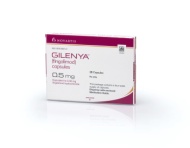Product
Gilenya
Approval Date
September 21, 2010
Release Date
October 21, 2010
Company
Novartis
Class
Sphingosine 1-phosphate receptor modulator.
Indication
For relapsing forms of multiple sclerosis (MS): to reduce the frequency of clinical exacerbations and to delay the accumulation of physical disability.
Active Ingredient
Fingolimod
Agency Roster
The CementBloc (professional)
Marketing Strategy/Execution
Gilenya is not only considered a major breakthrough in treating MS; it’s also the first oral drug available to patients with the CNS disease, which affects roughly 400,000 in the US. Novartis is closely managing the launch to ensure patients have access, helping reimburse for medical costs and out-of-pocket insurance co-pays for some patients. Safety concerns remain an issue. The FDA requires new patients to undergo monitoring for a decrease in heart rate. Still, the oral administration of the drug makes it a compelling choice for first-line treatment. Novartis beat Merck and its oral MS drug, cladribine (Movectro), to the US market, and the FDA’s decision to extend the priority review period for cladribine by three months, from November 2010 to February 2011, gives Gilenya more time to cement its hold.
Physician Outlook
The launch of Gilenya, the first oral disease modifying therapy for MS, introduces a major shakeup for this market. Although neurologists welcome this oral addition to their MS arsenal, managed care restrictions as a result of Novartis’ high pricing and monitoring requirements will temper uptake. Nevertheless, a needle-weary, eager patient population will be seeking out this new treatment option and may help drive usage.
—Louise Gillis, Associate Vice President, Research, GfK HealthCare
Also in the Pipeline (courtesy of Adis R&D Insight)
Drug: Campath
Manufacturer:Bayer Schering Pharma
Indication: Multiple sclerosis
Active ingredient: Alemtuzumab
Phase: III
Drug: BG-12
Manufacturer: Biogen Idec
Indication: Multiple sclerosis (Combination therapy:+ Interferon beta or glatiramer acetate)
Active ingredient: Dimethyl fumarate
Phase: II
Drug: Movectro
Manufacturer: Merck
Indication: Multiple sclerosis
Active ingredient: Cladribine
Phase: Preregistration
Drug: Daclizumab high-yield process
Manufacturer: Biogen Idec
Indication: Multiple sclerosis
Active ingredient: Daclizumab
Phase: III
Drug: Laquinimod
Manufacturer: Teva Pharmaceutical Industries
Indication: Multiple sclerosis
Active ingredient: Laquinimod
Phase: III
Drug: BIIB 017
Manufacturer: Biogen Idec
Indication: Multiple sclerosis
Active ingredient: PEG-interferon beta-1a
Phase: III
Drug: Teriflunomide
Manufacturer: Sanofi-Aventis
Indication: Multiple sclerosis
Active ingredient: Teriflunomide
Phase: III
Drug: CellCept
Manufacturer: Chugai Pharmaceutical
Indication: Multiple sclerosis
Active ingredient: Mycophenolate mofetil
Phase: II/III
Drug: Ocrelizumab
Manufacturer: Biogen Idec
Indication: Multiple sclerosis
Active ingredient: Ocrelizumab
Phase: II
Source: Wolters Kluwer Pharma Solutions
Adverse Reactions
Headache, influenza, diarrhea, back pain, increased liver transaminases, cough, hypertension; transient decreased heart rate and AV conduction, increased infection risk, macular edema, decreased pulmonary function.
Adults
0.5mg once daily. Monitor 1st dose (6 hours).
Children
Not recommended.
Precautions
Active acute or chronic infection: do not start treatment until infection resolved. Obtain recent CBC before starting treatment. Consider suspending therapy if serious infection develops; monitor for infections during treatment and for 2 months after discontinuation. Test for antibodies to varicella zoster virus; consider immunization before starting fingolimod. Immunosuppressed. Cardiac risk factors: monitor for bradycardia for 6 hours after 1st dose; consider baseline ECG. Bradycardia (<55bpm). History of syncope. Sick sinus syndrome. 2nd or 3rd degree heart block. Cardiac ischemia. CHF. QT prolongation. Arrhythmias. Diabetes, history of uveitis: increased risk of macular edema. Monitor visual acuity and for visual disturbances. Do ophthalmic exam at baseline, and at 3–4 months after starting therapy. Recent LFTs (eg, within 6 months) should be available; monitor; discontinue if liver injury occurs. Respiratory dysfunction. Renal or severe hepatic impairment. Pregnancy (Cat.C) (use effective contraception during and for 2 months after discontinuation), nursing mothers: not recommended.
Interactions
Potentiated by ketoconazole. Class Ia (eg, quinidine, procainamide) or Class III antiarrhythmics (eg, amiodarone, sotalol), β-blockers, calcium channel blockers: increased risk of bradycardia. Avoid live virus vaccines during treatment and for 2 months after discontinuing fingolimod; may have suboptimal response. Caution with antineoplastic, immunosuppressant or immunomodulating therapies: increased risk of immunosuppression.








